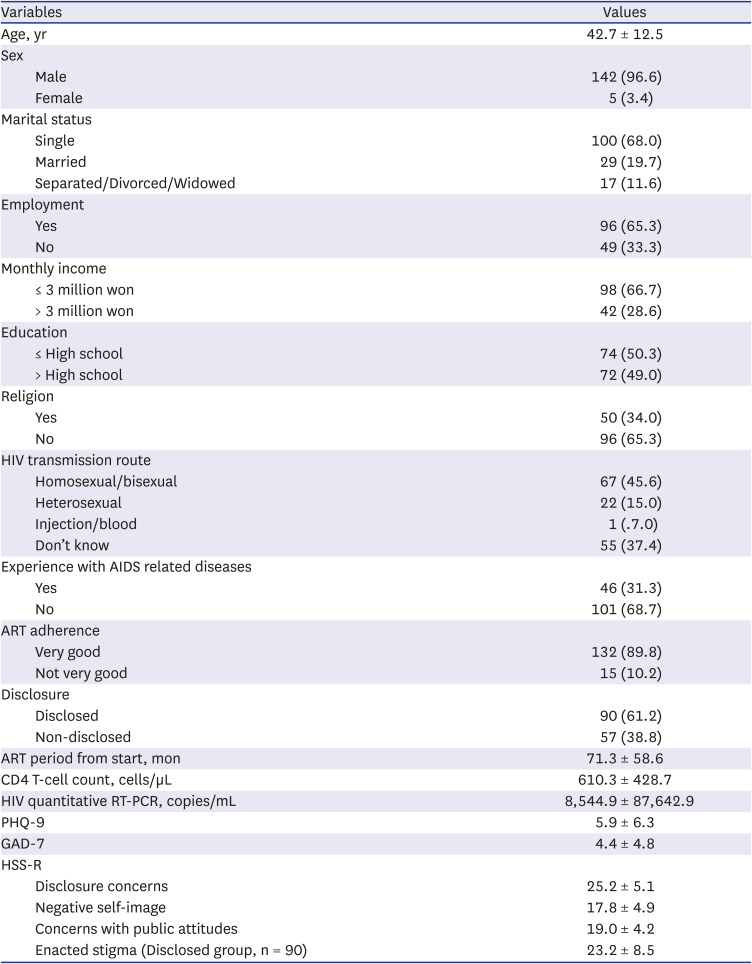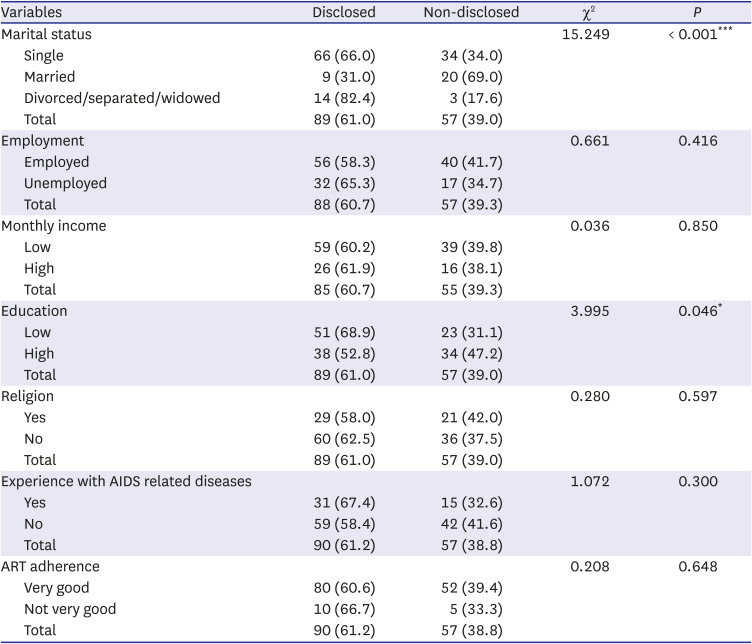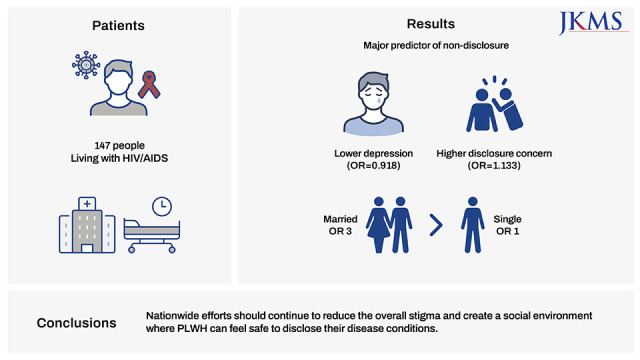1. Zea MC, Reisen CA, Poppen PJ, Bianchi FT, Echeverry JJ. Disclosure of HIV status and psychological well-being among Latino gay and bisexual men. AIDS Behav. 2005; 9(1):15–26. PMID:
15812610.
2. Simoni JM, Pantalone DW. HIV disclosure and safer sex. Kalichman SC, editor. Positive Prevention: Reducing HIV Transmission among People Living with HIV/AIDS. Boston, MA, USA: Springer;2005. p. 65–98.
3. Yu Y, Luo D, Chen X, Huang Z, Wang M, Xiao S. Medication adherence to antiretroviral therapy among newly treated people living with HIV. BMC Public Health. 2018; 18(1):825. PMID:
29973167.
4. Préau M, Beaulieu-Prévost D, Henry E, Bernier A, Veillette-Bourbeau L, Otis J. HIV serostatus disclosure: development and validation of indicators considering target and modality. Results from a community-based research in 5 countries. Soc Sci Med. 2015; 146:137–146. PMID:
26513123.
5. Chaudoir SR, Fisher JD, Simoni JM. Understanding HIV disclosure: a review and application of the Disclosure Processes Model. Soc Sci Med. 2011; 72(10):1618–1629. PMID:
21514708.
6. Nachega JB, Morroni C, Zuniga JM, Sherer R, Beyrer C, Solomon S, et al. HIV-related stigma, isolation, discrimination, and serostatus disclosure: a global survey of 2035 HIV-infected adults. J Int Assoc Physicians AIDS Care (Chic). 2012; 11(3):172–178. PMID:
22431893.
7. Henry E, Bernier A, Lazar F, Matamba G, Loukid M, Bonifaz C, et al. “Was it a mistake to tell others that you are infected with HIV?”: factors associated with regret following HIV disclosure among people living with HIV in five countries (Mali, Morocco, Democratic Republic of the Congo, Ecuador and Romania). Results from a community-based research. AIDS Behav. 2015; 19(2):311–321. PMID:
25533922.
8. Nanni MG, Caruso R, Mitchell AJ, Meggiolaro E, Grassi L. Depression in HIV infected patients: a review. Curr Psychiatry Rep. 2015; 17(1):530. PMID:
25413636.
9. Ezeamama AE, Woolfork MN, Guwatudde D, Bagenda D, Manabe YC, Fawzi WW, et al. Depressive and anxiety symptoms predict sustained quality of life deficits in HIV-positive Ugandan adults despite antiretroviral therapy: a prospective cohort study. Medicine (Baltimore). 2016; 95(9):e2525. PMID:
26945347.
10. Hill LM, Maman S, Kilonzo MN, Kajula LJ. Anxiety and depression strongly associated with sexual risk behaviors among networks of young men in Dar es Salaam, Tanzania. AIDS Care. 2017; 29(2):252–258. PMID:
27469516.
11. Brittain K, Mellins CA, Remien RH, Phillips T, Zerbe A, Abrams EJ, et al. HIV-status disclosure and depression in the context of unintended pregnancy among South African women. Glob Public Health. 2019; 14(8):1087–1097. PMID:
30584810.
12. Earnshaw VA, Chaudoir SR. From conceptualizing to measuring HIV stigma: a review of HIV stigma mechanism measures. AIDS Behav. 2009; 13(6):1160–1177. PMID:
19636699.
13. Smith R, Rossetto K, Peterson BL. A meta-analysis of disclosure of one’s HIV-positive status, stigma and social support. AIDS Care. 2008; 20(10):1266–1275. PMID:
18608080.
14. Hult JR, Wrubel J, Bränström R, Acree M, Moskowitz JT. Disclosure and nondisclosure among people newly diagnosed with HIV: an analysis from a stress and coping perspective. AIDS Patient Care STDS. 2012; 26(3):181–190. PMID:
22256856.
15. Kim GS, Shim MS, Yi J. Using decision tree analysis to understand the influence of social networks on disclosure of HIV infection status. AIDS Care. 2022; 34(1):118–126. PMID:
34292105.
16. Bunn JY, Solomon SE, Miller C, Forehand R. Measurement of stigma in people with HIV: a reexamination of the HIV Stigma Scale. AIDS Educ Prev. 2007; 19(3):198–208. PMID:
17563274.
17. Chapman Lambert C, Westfall A, Modi R, Amico RK, Golin C, Keruly J, et al. HIV-related stigma, depression, and social support are associated with health-related quality of life among patients newly entering HIV care. AIDS Care. 2020; 32(6):681–688. PMID:
31167537.
18. Turan B, Crockett KB, Buyukcan-Tetik A, Kempf MC, Konkle-Parker D, Wilson TE, et al. Buffering internalization of HIV Stigma: implications for treatment adherence and depression. J Acquir Immune Defic Syndr. 2019; 80(3):284–291. PMID:
30531493.
19. Berger BE, Ferrans CE, Lashley FR. Measuring stigma in people with HIV: psychometric assessment of the HIV stigma scale. Res Nurs Health. 2001; 24(6):518–529. PMID:
11746080.
20. Han C, Jo SA, Kwak JH, Pae CU, Steffens D, Jo I, et al. Validation of the Patient Health Questionnaire-9 Korean version in the elderly population: the Ansan Geriatric study. Compr Psychiatry. 2008; 49(2):218–223. PMID:
18243897.
21. Ahn JK, Kim Y, Choi KH. The psychometric properties and clinical utility of the Korean version of GAD-7 and GAD-2. Front Psychiatry. 2019; 10:127. PMID:
30936840.
22. Choi BY, Choi JY, Han SH, Kim SI, Kee MK, Kim MJ, et al. Korea HIV/AIDS cohort study: study design and baseline characteristics. Epidemiol Health. 2018; 40:e2018023. PMID:
30134649.
23. Cha J, Hwang SH, Oh EJ, Yun J, Kong I. State public relations policy for AIDS prevention in South Korea. Public Health Wkly Rep. 2019; 12(48):2151–2159.
24. Pitasi MA, Chavez PR, DiNenno EA, Jeffries WL 4th, Johnson CH, Demeke H, et al. Stigmatizing attitudes toward people living with HIV among adults and adolescents in the United States. AIDS Behav. 2018; 22(12):3887–3891. PMID:
29948338.
25. Yin Y, Yang H, Xie X, Wang H, Nie A, Chen H. Status and associated characteristics of HIV disclosure among people living with HIV/AIDS in Liangshan, China: a cross-sectional study. Medicine (Baltimore). 2019; 98(31):e16681. PMID:
31374050.
26. Ko NY, Lee HC, Hsu ST, Wang WL, Huang MC, Ko WC. Differences in HIV disclosure by modes of transmission in Taiwanese families. AIDS Care. 2007; 19(6):791–798. PMID:
17573600.
27. Vyavaharkar M, Moneyham L, Corwin S, Tavakoli A, Saunders R, Annang L. HIV-disclosure, social support, and depression among HIV-infected African American women living in the rural southeastern United States. AIDS Educ Prev. 2011; 23(1):78–90. PMID:
21341962.
28. Okello ES, Wagner GJ, Ghosh-Dastidar B, Garnett J, Akena D, Nakasujja N, et al. Depression, internalized HIV stigma and HIV disclosure. World J AIDS. 2015; 5(1):30–40.
29. Abler L, Sikkema KJ, Watt MH, Hansen NB, Wilson PA, Kochman A. Depression and HIV serostatus disclosure to sexual partners among newly HIV-diagnosed men who have sex with men. AIDS Patient Care STDS. 2015; 29(10):550–558. PMID:
26430721.
30. Feuillet P, Lert F, Tron L, Aubriere C, Spire B, Dray-Spira R, et al. Prevalence of and factors associated with depression among people living with HIV in France. HIV Med. 2017; 18(6):383–394. PMID:
27625202.
31. Charles B, Jeyaseelan L, Pandian AK, Sam AE, Thenmozhi M, Jayaseelan V. Association between stigma, depression and quality of life of people living with HIV/AIDS (PLHA) in South India - a community based cross sectional study. BMC Public Health. 2012; 12(1):463. PMID:
22720691.
32. Jeyaseelan L, Kumar S, Mohanraj R, Rebekah G, Rao D, Manhart LE. Assessing HIV/AIDS stigma in south India: validation and abridgement of the Berger HIV Stigma scale. AIDS Behav. 2013; 17(1):434–443. PMID:
22246514.
33. Marks G, Crepaz N. HIV-positive men’s sexual practices in the context of self-disclosure of HIV status. J Acquir Immune Defic Syndr. 2001; 27(1):79–85. PMID:
11404524.
34. Zea MC, Reisen CA, Poppen PJ, Echeverry JJ, Bianchi FT. Disclosure of HIV-positive status to Latino gay men’s social networks. Am J Community Psychol. 2004; 33(1-2):107–116. PMID:
15055758.
35. Nobre N, Pereira M, Roine RP, Sutinen J, Sintonen H. HIV-related self-stigma and health-related quality of life of people living with HIV in Finland. J Assoc Nurses AIDS Care. 2018; 29(2):254–265. PMID:
28935441.
36. OECD. Education at a Glance 2020: OECD Indicators. Paris, France: OECD Publishing;2020.
37. Nokes KM, Holzemer WL, Corless IB, Bakken S, Brown MA, Powell-Cope GM, et al. Health-related quality of life in persons younger and older than 50 who are living with HIV/AIDS. Res Aging. 2000; 22(3):290–310.
38. Emlet CA. A comparison of HIV stigma and disclosure patterns between older and younger adults living with HIV/AIDS. AIDS Patient Care STDS. 2006; 20(5):350–358. PMID:
16706709.
39. Solomon K. Psychosocial issues. Nokes KM, editor. HIV/AIDS and the Older Adult. New York, NY, USA: Taylor & Francis;2020. p. 33–46.
40. Jang S, Rim HD, Kim K, Kim BS, Woo J. Psychiatric understanding and treatment consideration in HIV infection. J Korean Soc Biol Ther Psychiatry. 2020; 26(3):184–194.










 PDF
PDF Citation
Citation Print
Print




 XML Download
XML Download